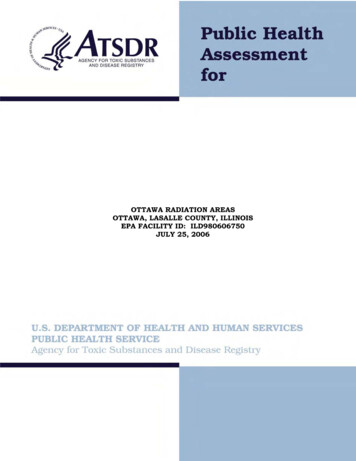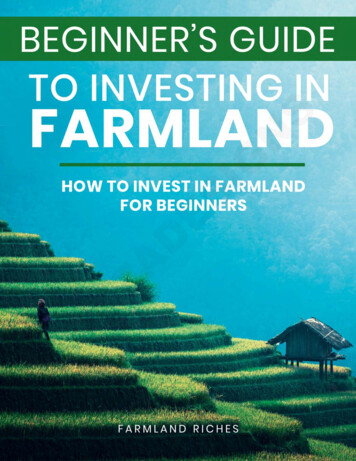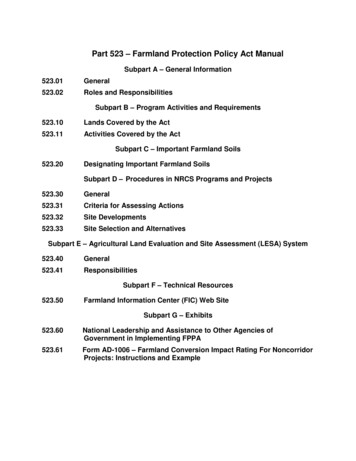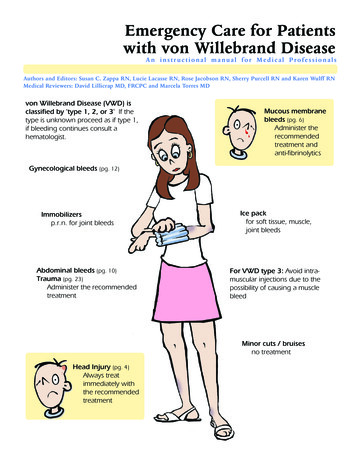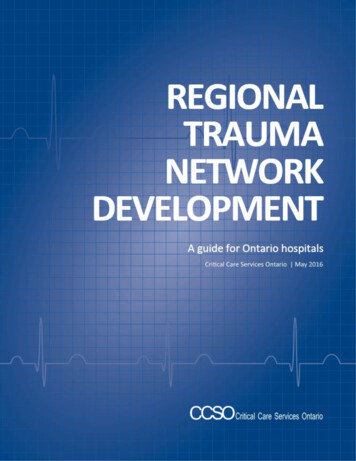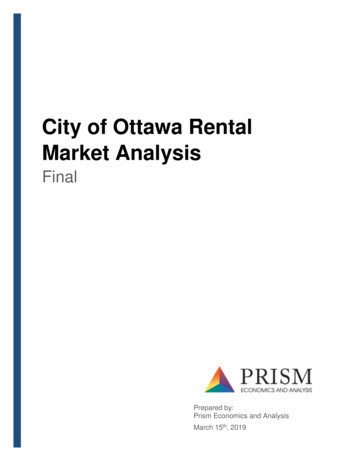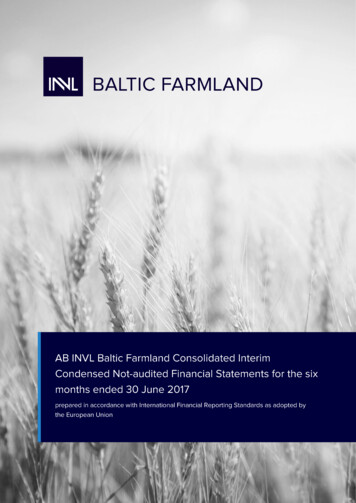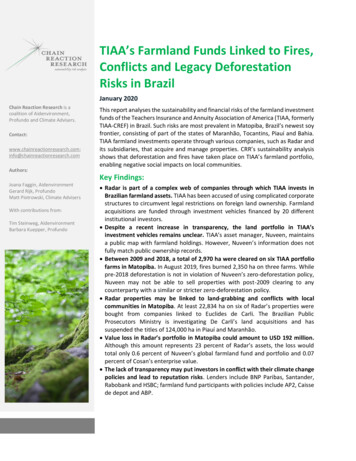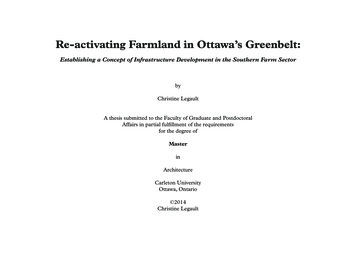
Transcription
Re-activating Farmland in Ottawa’s Greenbelt:Establishing a Concept of Infrastructure Development in the Southern Farm SectorbyChristine LegaultA thesis submitted to the Faculty of Graduate and PostdoctoralAffairs in partial fulfillment of the requirementsfor the degree ofMasterinArchitectureCarleton UniversityOttawa, Ontario 2014Christine Legaulti
ABSTRACTEstablished by the Greber Plan in 1950, the objective of Ottawa’s Greenbelt was to create a federally owned green space that would contain theurban sprawl of the city. At the time of expropriation, the land mass thatis now considered “the Greenbelt” was actively used for agriculture.Sixty-four years later, the population of Ottawa has outgrown its originalboundaries and the Greenbelt has effectively become a transit corridor forthe city’s urban and suburban populations. The greenbelt is farmed lessand less with each passing year and more questions arise as to its rolewithin the city.This thesis explores the kinds of infrastructure that could be developedto reactivate Ottawa’s Greenbelt. It includes a design proposal for theSouthern Farm Sector that envisions a productive agricultural landscapefocused on the production of locally grown food, public engagement andeducation, and sustainable development.i
figure 1. Farmhouse in the west end of Ottawa’s Greenbelt after being damaged by firefigure 2. Dilapidated barn after heavy snow loads caused the roof to collapsefigure 3. Typical exterior barn conditionfigure 4. Drastic example of an abandoned farmhouse interior takeover after being taken over by squattersii
AcknowledgementsTo Mom and Dad- thank you for loving me more than words can say. You have always provided mewith endless opportunities to explore my imagination, I am so grateful to have both of you as my parents.Marc, Adele, Roman and Kirsten- thank you for all your love and support.To Jenn and Gerry, for being the seed of this creative journey. For all the encouragement, resources andtools along the way. I can’t imagine my live without either of you in it.To my friends, the most wonderfully eclectic group of individuals I hold so dear to my heart. Thank youfor all your love and support.To Professor Lucie Fontein, thank you for your undivided patience and support throughout the writing ofthis thesis. I am infinitely grateful to you for your feedback and attention you’ve so generously given me. Ifeel very fortunate to have had you as a supervisor.iii
“Food contributes around one quarter of our ecological footprint. It can therefore be asignificant factor in the development of sustainable communities. As planners, architectsand developers, we can consider how to facilitate more healthy and sustainable diets. On aregional scale, we have the opportunity to re-invest the relationship between urban areas andtheir rural hinterland to increase the availability of local, organic and seasonal food- so called“bioregionalism”. We can also consider master planning to promote urban agriculture, farmer’s markets and more allotment space, and consider community centers as drop off pointsfor local food. To increase happiness and increase sustainability we should grow more of ourown food. We should integrate herb boxes, sky gardens, community gardens, allotments, rooftopmini-allotments and edible landscaping into our architecture.” (Viljoen, CPUL- p.49)Andre Viljoen, author of ContinuouslyProductive Landscape (2010)iv
TABLE OF PTER ONE- Site Context1.0 Introduction1.1 Understanding the Greenbelt Ideology1.2 Establishment of Ottawa and the implementation of ‘the Greber Plan’1.3 Creation of ‘The Greenbelt’1.4 Failures of the Greenbelt1.5 The Current Condition of Ottawa’s Greenbelt1.6 Reasons for deteriorating of Agricultural Infrastructure1.7 Advantages of Greenbelt Land Use1.8 Thesis Question1.9 Referencesp.2p.3p.4p.5p.5p.7p.9p.10p.11p.12CHAPTER TWO- Agricultural Context2.0 Introduction2.1 Overview of the current Canadian agricultural landscape2.1.A- Fewer, but larger establishments2.1.B- The Impact of Free Trade on Canadian Farms2.1.C. Increased Cost of Farmland2.1.D Aging Population2.2 Possible Futures for the Canadian Agricultural Landscape2.3 Alternative Methods of ER THREE- Case Studies3.0 Introduction3.1 Case Study 1- Souther Farm Development Plan3.2 Case Study 2- Ottawa “Just Foods”3.3 CPUL- R-Urban, Paris, France3.4 Four Fields3.5 R FOUR- Design4.0 Introduction.4.1 Defining design criteria4.2 Site Selection4.3 Determining Architectural program4.4 Creating a Link4.5 Defining a Major Design Component4.6 Continuing the Path4.7 A note on materiality4.8 TER FIVE- Conclusion5.0 Conclusionp.58v
PROLOGUEAt the very beginning of my journey in architecture, I worked two consecutive summers for the Heritage Departmentof the National Capital Commission (NCC) in Ottawa, Ontario. My role was to document the NCC’s existing assetsin Ottawa’s Greenbelt, as they are the land holders for this federally owned land. My task was to submit files of theirexisting farm infrastructure to the Federal Heritage Building Review Board (FHBRO) under Parks Canada. Based onthese submissions, the review board was to evaluate the heritage status of barns, farmhouses and outbuildings. Sincethe majority of these buildings have been abandoned or were left unused for long periods of time after they wereexpropriated in 1965, very few of them ever received heritage status.The NCC works hard to maintain the land with the available resources given to them. However, the lack of publicengagement and interest in the Greenbelt makes it difficult for the organization to vouch for the significance andfinancial upkeep of the buildings. The unfortunate result is often that the buildings fall into disrepair and are eventuallydemolished.Although there has there been a gradual loss in agricultural infrastructure since the time of expropriation, the bulk of theland remains designated as agricultural farmland for the use of the public. As written in their most current masterplanin 2012, the NCC, continues to aspire to reaching an ideal of greater agricultural production in the Greenbelt.This thesis seeks to uncover the possibility of what this could look like.*It is important to note that although the NCC was made aware of this project, they, in no way, endorse or are partners in this thesis.All research attempts to reflect an accurate representation of Ottawa’s Greenbelt and was done through consulting public records and information.1
CHAPTER ONE- SITE CONTEXTApproaching Ottawa’s Greenbelt as a Land Mass Within the CityIntroduction1876It is difficult to ignore the presence of Ottawa’s greenbelt. Approximately 33% of ourpopulation, residents of the surrounding suburbs of Kanata, Barrhaven and Orleans, drives1directly through the greenbelt on their daily commute. Given that by 2011, 88% of Ottawa’sresidents lived in auto suburbs, transit suburbs or exurban areas, and an additional 55%may intersect the Greenbelt at some point in their day (Cook, 2012). When asked of thisland’s purpose, however, many citizens are ignorant about the Greenbelt’s role in the city.1925Are farmer’s using the land? Why hasn’t it been developed for housing or industry? We areleft scratching our heads. Ottawa’s growing population increases the urgency to clarify thepotential of the Greenbelt: its uses and functions, as well as its role in the future of Ottawa’sdevelopment.This first chapter explores the concept of greenbelts, and the way it has shaped the city ofOttawa through the implementation of the ‘Greber Plan’, and the failures and realities of1956the land since expropriation. Specifically, it identifies reasons for the deterioration of theinfrastructure, and the advantages and disadvantages of becoming a tenant farmer on the land.Finally, it establishes a context in which to evaluate types of infrastructure development andthe ways in which active community engagement with the Greenbelt might take place.2010figure 1-1. Growing population of Ottawa. (NCC 2010)1. A new national study shows that although Canada is routinely described as an urban nation, 67 percent of us, or 22.4 million people actually live insuburban neighbourhoods In the city of Ottawa in 2012: 528,900 people lived inside the greenbelt and 406,100 lived outside it’ - with 96% of growth inthe suburbs. (Cook, 2012)2
1.1 Understanding the Greenbelt IdeologyThe concept of a ‘Greenbelt’ dates back to 1580 when the Queen ofEngland, Elizabeth I, declared, “a city of great multitudes needs restrictionsto prevent crowded housing and great poverty” (Mandelker, 27). It wasn’tuntil the 19th century, however, that a more refined concept- the ‘gardencity’ caught the public’s imagination. The concept “was a reaction to theugliness of the industrial revolution, which has separated the Englishmanfrom the countryside and had crowded him into drab and teeming cities”(Mandelker- p.28). The main objectives of typical ‘garden-city’ plans were toi) maintain a balance between town and country ii) protect agricultural land2iii) regulate city growth and iv) ensure the furtherance of local governmentpolicy. (Mandelker, p.32-35)figure 1-2. City of Ottawa, Photograph. Greber Plan . 1950The problems and realities of the 16th and 19th century city are entirelydifferent from those we are presented with in 2013. For instance, lifestyleswere not dependent on any of the machines we currently rely on, andpublic services were not available in the same basic capacities we now takefor granted. In the late 19th century, innovations such as the automobile,plumbing, and electricity, were introduced; but while these were prevalent inthe homes of the rich, they were not yet part of the lifestyle of the commonman. Priorities and daily routines differed greatly between the rich andpoor. Cities were often seen as dirty due to pollutants from local industry,family farms were a significant part of the economy, and there was a dividebetween the city and the country. The concept of ‘suburbs’ did not yet exist.figure 1-3. Greber Plan Masterplan (Plate 8) 19503
However, drastic changes were on their way. With the end of the industrialrevolution (1760-1840) and the coinciding rise of the middle class, prioritiesand lifestyles began changing into ones that we would better recognize today.1.2 Establishment of Ottawa, the Federal District Commission (FDC)the National Capital Commission (NCC) and implementation of‘The Greber Plan’Queen Victoria chose Ottawa as Canada’s capital in 1857. Ottawa, waschosen to be the nation’s capital because of its proximity to the river andits location halfway between Toronto and Quebec City. It’s landscape, wasrepresentative of most other rural cities in the country at that time- largelypopulated by farmers’ fields. Its industry relied heavily on the lumber trade,but this would soon change with the establishment of the federal governmentand its demand for public servants.After the construction of the Parliament buildings, and the permanentestablishment of the city, the Federal District Commission (FDC) wascreated in 1927, later replaced by the National Capital Commission (NCC)in 1959. The Commission was created in the hopes of establishing a politicalparty that would represent the interests of Ottawa as the nation’s capital.The NCC’s mandate, which has remained relatively unchanged for thepast 50 years, has been to ‘provide a source of pride and inspiration for allCanadians.’ (NCC, 2011)In 1950, the Greber Plan was submitted to the FDC and was implementedshortly afterwards. The goals of the Greber Plan were similar to other “garden-4
city” development plans created during that time; to 1) relocate the railwaynetwork and heavy industry outside of the city’s core; 2) reorganize the roadnetwork and create a scenic parkway; 3) create a rural belt, the Greenbelt, tocontain urban growth; 4) create a network of parks, green spaces, pathways2and open spaces, and 5) establish a decentralization of government buildingswith the creation of four nodes to accommodate research and administration(Tunneys Pasture, Booth Street Complex, Confederation Heights, RCMPand Montreal Road Complex). (NCC, 2011)1.3 Creation of ‘The Greenbelt’Although all five of these recommended strategies have been implementedin Ottawa, and have taken on their own shapes, the focus of this thesis is onthe third initiative of the Greber Plan- the creation of the Greenbelt. Movingforward it is this strategy that holds the most potential for improvement andre-evaluation. The land mass was expropriated between 1958 and 1966 ata total cost of 40 million and occupies an area of approximately 16,600hectares. Approximately 83% of the original Greenbelt area was privatelyowned, in varying degrees, by approximately 1000 owners. Of these, some600 were agricultural producers: dairy farmers, poultry producers andmarket gardeners. (Nixey p.5)1.4 Failures of the GreenbeltJacques Greber, the author of the Greber Plan, was a city planner rootedin the history of his time. His ‘Greber Plan’ for the city of Ottawa, hasa significant focus on neighbourhood analysis and current populationdemographics. However, his analysis failed to consider three significantand emerging societal changes at that time: firstly, Greber did not properly2. A maximum city population of 500,000 people is often cited as a city’s population limit5
project the growth of the middle class and its demands as consumers. Babyboomers and the generations following them have been mostly interestedin large homes on affordable land. This interest resulted in an influx ofpeople building homes on the exterior boundary of the greenbelt. Thesecommunities eventually became the suburbs of Kanata, Barrhaven andOrleans. In 2001, these suburbs were amalgamated into the city of Ottawa,officially transforming the greenbelt from the city limit to an ‘in-between’zone of the city.Secondly, Greber failed to evaluate the role of the automobile in our futurelifestyles, thus failing to see the ability and convenience of ‘hoping thegreenbelt’ in order to get to other parts of the city. Thirdly, Greber didnot foresee proper population projections for the city. Figure 1 illustratesGreber’s population projections for 2020.Within the greenbelt itself, the agricultural land has continued to deteriorate.Before expropriation in 1961, 71% of the greenbelt (10,900 hectares ofthe 15,200 ha total) was used for farming, the majority being used forintensive livestock production (MacNabb, 1967). Included in this area wereapproximately 40 ha in market gardens, mostly in the Renaud Road area. Theland was also used for horse ranches, poultry farms, apiaries and orchardsat the time. By 1969, the area being farmed in the Greenbelt dropped toapproximately 6100ha. By 1972, this figure was closer to 4900ha because oftransfers to other uses or area that had lost its agricultural potential (Nixey,p.5-6). As of 1993 report, there are 85 farm leases in the Greenbelt.Today, some of these farms continue to be operated under what the NCCconsiders, ‘long-term land leases’. These leases have typically been given tofamilies remaining as tenants on the land after expropriation. The numberfigure 1-4. Greber ‘s population projection, overlaid with actual population size for 20116
of these long-term land leases, however, are dwindling. Sixty-years after itsinception, the city of Ottawa continues to be shaped by the Greenbelt. Thisis despite the fact that the original intentions for the land have not beenfulfilled. It has not ‘prevented urban sprawl’ and the agricultural land iscontinuing to deteriorate.1.5 The Current Condition of Ottawa’s GreenbeltEvery year fewer and fewer farms are in operation in the Greenbelt.The following figures are of Ottawa’s Greenbelt in its current condition(2013). The demolished farm sites represent infrastructure, mostly barns,which were on the land when expropriated in 1965-66. All imagery analysisfor the figures was retrieved from the City of Ottawa archives (Geo Ottawa)figure 1-5. Overview of Greenbelt with sections determined for analysisand the analysis was done by comparing photographs from 1965 to 2011.This trend is reflected in the analysis of zone 5 of theThis data represents the most current and accurate, state of the greenbelt.greenbelt (the eastern part of the greenbelt) - withthe highest percentage of farms being lost, 31 farms/With no new infrastructure being built and little maintenance being donepieces of infrastructure having been demolished sinceon the buildings that do still exist- the Greenbelt is shifting from a onceexpropriation, and the most successful ones being in theproductive space that reflected the history of our land to an increasinglysouth western zones of the greenbelt.underutilized area of the city. This trend is particularly serious in the easternpart of the greenbelt.“The farm buildings in the western farm zone are a combination of theoriginal buildings purchased by the NCC and some new ones that havebeen added as replacements to accommodate tenant needs. A numberof older facilities have undergone recent improvements. While somebarns still appear to require repairs to the roof, siding or foundation,the buildings are generally adequate for the type and scale of operationsbeing carried out by the tenants. Farm buildings in the eastern zone are,in general, not in as good a condition as those in the west. Approximatelyone half of the houses and three quarters of the farm buildings are inneed of repairs and maintenance. (Nixey, p.28)figure 1-6. Zone 5 of Ottawa’s Greenbelt, showing the highest number of lost infrastructure7
6figure 1-7. Summary Map of Lost vs. Existing infrastructure since expropriation152site with infrastructure at timeof expropriation, which is now(2011) been demolishedcluster of sites with infrastructurelosssites with remaininginfrastructure (mainly farms)43figure 1-8. Resulting maps of Ottawa’s Greenbelt analysis from GeoOttawa imagery8
1.6 Reasons for deterioration of AgriculturalInfrastructureWhy is there such a significant loss in agricultural infrastructure? The landis viable for farming (as it has been for the past 200 years), the landowners(NCC) are willing to rent the land, and, as will be discussed in the followingchapter, there is currently a demand for local produce. So why have all thesefarms gone without tenants, maintenance, and consequently, why have theyarrived at a point where demolition is the only suitable course of action?Nixey’s Agricultural Analysis of the Greenbelt identifies the following keyfactors that explain why there is a lack of interest in using the greenbelt forits designated purpose. Firstly, the leasing policy between the NCC and thetenants is highly bureaucratic. Anything over a five-year land lease requires alengthy submission to the Treasury Board of Canada. This creates problemsrelated to a tenants investments in setting up the infrastructure and obtainingthe collateral necessary to start a farm. Secondly, maintenance or upkeep onthe buildings is repayable in the form of rent back to the NCC (Nixey, p.29).A farmer must therefore be willing to rent a piece of land and pay for basicupkeep of his or her rented property. Thirdly, farmers are not eligible forprovincial farmland tax rebates because they do not own the land. Finally,there is little incentive for building upkeep and tenants are unable to buildequity (Nixey, p.41-42)These disadvantages are magnified even further. Currently, the NCC’sonly model of food production is through independent leases, placing theresponsibility largely on the farmer. The land and infrastructure couldbe better used if it were made accessible to the public. In the NCC’s9
greenbelt masterplan, the organization emphasizes the importance of publicengagement with the land. They state:“The Greenbelt of Canada’s Capital is a unique place. These 21,500hectares within Canada’s Capital Region (CCR) belongs to the people ofCanada. The Greenbelt is the most ecologically diverse natural landscapewithin an urban area. The greenbelt supports a viable base of primeagricultural lands that in close proximity to a large urban population.It is also a myriad of places and experiences for recreation that providesolitude, observation of nature, the opportunity for many forms ofexercise, glimpses into the experiences of our ancestors or connectionwith our local food system” (NCC, Greenbelt Masterplan (p.5), 2012)It is time to develop infrastructure with public use in mind, with the intentionof introducing the public to agricultural practices, our cultural heritage, andthe outdoors (and related activities). Otherwise, these small-scale farms willcontinue to depreciate in value and eventually disappear.1.7 - Advantages to Greenbelt Land UseThere are special circumstances to farming in the Greenbelt that can be seenas advantageous. First, the shape and location of the Greenbelt is unique.Despite the growth of the city, the greenbelt has stayed virtually untouchedfor more than 60 years, and it now benefits from the proximity to both urbanand suburban populations. This puts farmers in direct proximity to potentialmarkets with an easily accessible off-site labour force. Secondly, with theoption to rent the land, rather than purchase it, there are lower start-up,expansion and maintenance costs. Thirdly, zoned as agricultural land andused that way in the past, a majority of the land is in excellent condition forfarming.10
1.8 Thesis QuestionGiven the special circumstances in which the Greenbelt exists in the cityof Ottawa, What kind of infrastructure can be developed in Ottawa’sGreenbelt that will help to reactivate the land into a productiveagricultural landscape?A possible solution will be tested through the design of a proposal forthe Southern farm District of the Greenbelt. It will be evaluated basedon its perceived potential as an educational tool and perceived ability toengage the public in agricultural activities. More specifically, the projectwill (1) address the space of the greenbelt as an opportunity for communitydevelopment and education of both our agricultural land and heritage; (2)maintain its objective of preserving agricultural land- as historically relevant,as well as an opportunity to address the growing demand of locally grownfood; (3) address both the five- year leasing policy and the need for upkeepand deteriorating existing infrastructure; and (4) captivate its audience andprovide a unique vision for the greenbelt to, once again, become a productivelandscape.11
Chapter 1 References:Cook, Maria. “Canada’s new identity: A suburban nation, two-thirds of Canadianslive in the suburbs, study find” www.ottawacitizen.com. Ottawa Citizen, 6 Sept.2012. Web. 04 Nov. 2013Greber, Jacques - Plan for the National Capital, General Report Submitted to theNational Capital Planning Committee. (1950)Herington, John “Beyond Green Belts: Managing Urban Growth in the 21stCentury”. Jessica Kingsley Publishers. London (1990)MacNabb , B.B. The National Capital Greenbelt. Research paper presented to theDivision of Town and Regional Planning, University of Toronto (M.Sc. Thesis)Toronto, Ontario (1967)Mandelker, Daniel R. Green belts and urban Growth (English Town and countryplanning in Action) The University Washington Press (1966)National Capital Commission, Horizon 2067: The Plan For Canada’s CapitalCharting The Future of Canada’s Capital in the 21st Century – Step 1- FoundationPaper (August 2011)Senes Consultants Limited prepared for the National Capital Commision,Greenbelt Masterplan Review, Phase 1- Step C: Land Use Concept (January 2012)Nixey, Daniel: The Future Greenbelt- Agricultural Analysis, Prepared for: TheNational Capital Commission Long Range Planning Division (November 1991)Osborn, Frederic J. “Green-Belt Cities” Schocken Books. New York (1969)12
CHAPTER TWO- AGRICULTURAL CONTEXTThe Canadian Agricultural Landscape of the 21st century2.0 IntroductionSince the objective of this thesis is to propose a way to reactivate theagricultural infrastructure of Ottawa’s Greenbelt, it is relevant to look atthe broader national state of agriculture in Canada. This chapter discussesthe current state of farming in Canada, the resulting impact on Canadianfarms, and alternate methods of farming for the future of agriculture.2.1 Overview of the Current Canadian Agricultural LandscapeAs with the societal shifts brought on by the industrial revolution in the‘garden-city movement,’ mass manufacturing coupled with the signing ofthe North American Free Trade Agreement (NAFTA) in 1994 made asignificant and profound impression on farming in Canada. Our local farmswere opened to an international marketplace. Monocrops have become themost efficient and lucrative form of farming, making mixed-crop farms lessdesirable. According to Agriculture Canada,“The real value of production has tripled over the last 45 years while thenumbers of farms have been halved”. –Agriculture Canada (2006)The shift to monocrops has led to the consolidation of the agri-food business.Four major trends have emerged in relation to Canada’s current state offarming. Firstly, there are now fewer, but larger farming establishments inCanada. Next, due to the effects of free trade and the emergence of neweconomies, Canadian farmers aren’t able to keep up with low cost labour13
forces in other countries. Thirdly, the cost of buying land and startingup a farm has gone up exponentially in recent years making it a difficultindustry to enter as a new farmer, and finally, due to changes in societalattitudes and the complexity of farming in the 21st century, fewer peopleare interested in farming as a way of life. As a result, the current farmingpopulation is aging and numbers are shrinking.2.1.A - Fewer, But Larger EstablishmentsAgricultural production is becoming more concentrated for every type offarm, especially on very large farms. Between 1961 and 2001, the numberof farms in Canada declined from approximately 500,000 to 250,000.However, the rate of decrease has slowed in recent years: between 1961and 1981 farm numbers dropped by 35%, whereas between 1981 and2001 farms exited and entered at a rate of 3 to 4%. (Agriculture Canada)Remarkably, this has not affected production levels: “the real value ofagricultural production tripled between 1961 and 2001, from about 12billion to 35 billion. Wheat production increased by 173% between 1961and 2001. During the same period, production of poultry increased by273% and that of pork by 318%.” (Agriculture Canada) This trend ofconsolidation and efficiency continues to influence the food processingindustry today.“In 1990, there were 3,700 food processing establishments in Canadawith an average value of shipment of 12 million. By 1999, thenumber of establishments had declined to 3,100 while the averageshipment had increased to about 20 million. The largest 5% of foodmanufacturing establishments accounted for over 50% of sales in2003 whereas the smallest 80% of establishments accounted for only15% of sales.” (Agriculture Canada (2006), Changing trends p.4)14
Additionally, these processes of mechanization have drasticallyinfluenced the availability of employment and have created an hourglassproduction model. In ‘Food Security, Michael Carolan states:“When looked at from gene to grocery bag- that is, from the inputsector all the way through to the consumer- the population of theagrifood chain takes on an hourglass figure that is precariously hangingon by a thread. Beyond the input sector, which is dominated by ahandful of global giants, we find a system with significant producerand consumer populations. The hourglass shape reflects the highlytruncated ‘middle where food processors and manufacturers andfood and beverage retailers reside.” (Carolen (2013) p.100)Both a monopoly and monopsony have been created in the agriculturalindustry as a result of this mass consolidation. The sellers get to set theirprices to the farmers for seed and manufacturing equipment, and on theopposite spectrum, because of the hourglass structure, the farmers areforced into a market condition that exists when there is only one buyer.Ultimately control is taken away from the actual food producer.figure 2-1. Michael Carolan (2013) hourglass shape model15
2.1.B- The Impact of Free Trade on Canadian FarmsThe second major impact on Canadian farmers has been the openingof free trade between countries. As previously noted, a large part ofour economy is reliant on creating exports for distribution and sale.However, because prices are set to a world market and competition iscoming from regions with low cost producers, it is increasingly difficultfor Canadians to exports bulk food supply.“Bulk commodities accounted for close to one half of exports inthe early 1990s. Today they constitute less than one quarter ofexports. At the same time, producers within the supply managementsystem have achieved steady productivity increases while focusingalmost exclusively on the domestic market.” (Agri-food industry Adiscussion Paper p.4)Furthermore, future international agreements likely will force acontinued reduction in the level and types of government support that allcountries, including Canada, can provide to their domestic agriculturalsectors. Over time, this will reshape governments’ relationship withindustry, as previous levels of government support and particular typesof programming may no longer be permissible. (Agri-food industry Adiscussion Paper p.6)2.1.C- Increased Cost of FarmlandAgriculture Canada states that there are a considerable number of newentrants to farming each year. However, these entrants face specificchallenges in establishing their operations, particularly with regards tofinancing and c
To Mom and Dad- thank you for loving me more than words can say. You have always provided me . 2.1.B- The Impact of Free Trade on Canadian Farms 2.1.C. Increased Cost of Farmland 2.1.D Aging Population . Priorities and daily routines differed greatly between the rich and poor. Cities were often seen as dirty due to pollutants from local .
